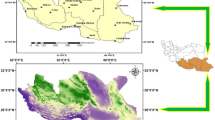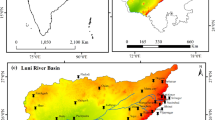Abstract
In the last decade, severe drought impacts have been witnessed in Jordan and there is an immense need to develop drought management strategy and policy framework to tackle this problem. This study aimed to investigate the spatio-temporal variability of precipitation based on long-term data using Standardized Precipitation Index (SPI) to assess the trend and intensity of drought in Jordan. In this context, the data of 29 meteorological stations of the last 37 years have been obtained from Jordan Meteorological Department. SPI-3, SPI-6 and SPI-12 have been calculated to assess short- and long-term drought events, and Mann–Kendall and linear regression tests were applied to detect the drought trend in the study region. Drought of varying duration and intensity was detected at each time scale (3-, 6-, and 12-month SPI) as well as at each meteorological station. The SPI results show that Jordan faces an increasing frequency of drought with a probability of occurrence once in every 2 or 3 years. On contrary to this, long-term drought occurs in whole country once in every 15–20 years which have more than 2-year consecutive duration. The Mann–Kendall test result shows significant temporal decrease in the amount of precipitation at all meteorological stations except Madaba. The results of linear regression test indicate significant increase in magnitude of drought with the rate 0.02/annum with a significance of 0.0001 using SPI values. This study concluded that there is an increasing drought trend and the situation will become more severe in future as the amount of rainfall is decreasing gradually in Jordan.
Similar content being viewed by others
References
Abu SA, Abu-Allaban M, Al-Malabeh A (2015) Temporal and Spatial Analysis of Climate Change at Northern Jordanian Badia. Jordan Journal of Earth and Environmental Sciences 7(2):87–93
ACSAD (2011) Drought vulnerability in the arab region: case study—drought in Syria
AMS, (American Meteorological Society) (2004) Statement on meteorological drought. Bull Am Meteorol Soc 85:771–773
Black E (2009) The impact of climate change on daily precipitation statistics in Jordan and Israel. Atmos Sci Lett 10:192–200
Dai A (2011) Drought under global warming: a review. WIREs Clim Change 2:45–65. https://doi.org/10.1002/wcc.81
Deo RC, Sahin M (2015) Application of the artificial neural network model for prediction of monthly standardized precipitation and evapotranspiration index using hydrometeorological parameters and climate indices in eastern Australia. Atmos Res 161(162):65–81
Deo RC, Kisi O, Singh VP (2017) Drought forecasting in eastern Australia using multivariate adaptive regression spline, least square support vector machine and M5Tree model. Atmos Res 184:149–175
Evans JP (2009) 21st century climate change in the Middle East. J Clim Change 92:417–432
FAO (2017) Drought and Agriculture. In: International seminar the Islamic Republic of Iran and the Kingdom of Netherlands, Rome
Gibbs WJ, Maher JV (1967) Rainfall deciles as drought indicators. Bureau of Meteorology, Melbourne
Gidey Eskinder, Dikinya Oagile, Sebego Reuben, Segosebe Eagilwe, Zenebe Amanuel (2018) Modeling the spatio-temporal meteorological drought characteristics using the standardized precipitation index (SPI) in Raya and its environs, Northern Ethiopia. Earth Syst Environ 2018:1–12
Gonçalves M, Barrera Escoda A, Guerreiro D, Baldasano JM, Cunillera J (2014) Seasonal to yearly assessment of temperature and precipitation trends in the North Western Mediterranean Basin by dynamical downscaling of climate scenarios at high resolution (1971–2050). Clim Change 122(1):243–256
Gopalakrishnan C (2013) Water and disasters: A review and analysis of policy aspects. Int J Water Resour Dev 29(2):250–271
Hammouri N, El-Naqa A (2007) Drought Assessment Using GIS and Remote Sensing in Amman-Zarqa Basin, Jordan. Jordan Jour Civ Eng 1(2):142–152
IPCC (2013) Climate change: the physical science basis. Working Group I contribution to the IPCC Fifth Assessment Report. Intergovernmental Panel on Climate Change. Cambridge, United Kingdom: Cambridge University Press. www.ipcc.ch/report/ar5/wg1. Accessed Sept 2013
JMP (2011) Statistics and graphics guide version 8. SAS Institute Inc., Cary
Kastopoulou, E., Giannakopoulos, C., Krapsiti, D., Karali, A., (2017) Temporal and spatial trends of the standardized precipitation index (SPI) in Greece using observations and output from regional climate models. In: Perspectives on atmospheric sciences springer atmospheric science, pp. 75–481
Kendall M (1975) Rank correlation methods, 4th edn. Charles Griffin, London
Langat PK, Kumar L, Koech R (2017) Temporal variability and trends of rainfall and streamflow in Tana River Basin, Kenya. Sustainability 9(1963):1–18. https://doi.org/10.3390/su9111963
Mahfouz P, Mitri G, Jazi M, Karam F (2016) Investigating the temporal variability of the standardized precipitation index in Lebanon. Climate 4:27. https://doi.org/10.3390/cli4020027
Mann H (1945) Non-parametric tests against trend. Econometrica 13:245–259
McKee TB, Doesken NJ, Kleist J (1993) The relation of drought frequency and duration to time scales. In: Proceedings of the eighth conference on applied climatology. Am Meteorol Soc, Boston, pp 179–184
McKee TB, Doesken NJ, Kleist J (1995) Drought monitoring with multiple time scales. In: Proceedings of the ninth conference on applied climatology. Am Meteorol Soc, Boston, pp 233–236
Milligan GW (1980) An examination of the effect of six types of error perturbation on fifteen clustering algorithms. Psychometrika 45:325–342
MoEnv (2014) Capacity development to support national drought management policy: drought conditions and management strategies in Jordan. Ministry of Environment, Amman
MWI (2010) Climate change mitigation and adaptation: advanced international training programme in Norrkoping–Sweden. In: October 25–November 19. Ministry of Water and Irrigation, Water Authority of Jordan, Jordan
MWI (2015) Jordan water sector facts and figures, Ministry of Water and Irrigation, Amman, Jordan. http://www.mwi.gov.jo/sites/en-us/Hot.Issues/JordanWaterSectorFactsandFigures2015.pdf. Accessed July 2015
Palfai I (1990) Description and forecasting of droughts in hungary. In: Proceedings of the 14th Congress on Irrigation and Drainage (ICID), Rio de Janario, Brazil; Volume 1-C, pp 151–158
Palmer WC (1965) Meteorological drought. U.S. Department of Commerce Weather Bureau, Washington, DC
Paulin C, Xiaogang S (2005) Identification of the effect of climate change on future design standards of drainage infrastructure in Ontario. Ontario, Canada
Rahman G, Atta-ur-Rahman Samiullah, Dawood M (2018) Spatial and temporal variation of rainfall and drought in Khyber Pakhtunkhwa Province of Pakistan during 1971–2015. Arab J Geosci 11(3):1–13
Selker JS, Keller CK, McCord JT (1999) Vadose zone processes. Lewis Publishers/CRC Press LLC, Florida
Sivakumar MVK (2005) Natural disasters and extreme events in agriculture, Chapter 1 of the book titled: impacts of natural disasters in agriculture, rangeland and forestry: an overview. Springer, Berlin
Surendran U, Kumar V, Ramasubramoniam, Raja P (2017) Development of drought indices for semi-arid region using drought indices calculator (DrinC)—a case study from Madurai District, a semi-arid region in India. Water Resour Manag. https://doi.org/10.1007/s11269-017-1687-5
Tigkas D, Vangelis H, Tsakiris G (2015) DrinC: a software for drought analysis based on drought indices. Earth Sci Inf 8(3):697–709. https://doi.org/10.1007/s12145-014-0178-y
Törnros T, Menzel L (2014) Addressing drought conditions under current and future climates in the Jordan River region. Hydrol Earth Syst Sci 18:305–318
Turk M, Levin N, Tessler N, Saaroni H (2016) Recent changes and relations among drought, vegetation and wildfires in the Eastern Mediterranean: the case of Israel. Glob Planet Change 151:28–35
UN (2013) Strengthening national capacities to manage water scarcity and drought in West Asia and North Africa: the analysis, mapping and identification of critical gaps in preimpact and preparedness drought management planning in waterscarce and in-transitioning-settings countries in West Aisa/North Africa. Department of Economic and Social Affairs (DESA), Economic and Social Commission for Western Asia (ESCWA)
UNISDR (2001) Drought vulnerability in the Arab Region: ten years of scarce water (2000–2010). ACSAD, UNISDR, Geneva
Van Loon AF (2015) Hydrological drought explained. Wiley Interdiscip Rev Water. 2:359–392
Vicente-Serrano SM, Begueria S, Lopez-Moreno JI (2010a) A multi-scalar drought index sensitive to global warming: the standardized precipitation evapotranspiration index3SPEI. J Clim 23:1696–1718
Vicente-Serrano SM, Begueria S, Lopez-Moreno JI, Angulo M, Kenawy EL (2010b) A new global 0.58 gridded dataset (1901–2006) of a multiscalar drought index: comparison with current drought index datasets based on the Palmer drought severity index. J Hydrometeorol 11:1033–1043
Vicente-Serrano SM, Lopez-Moreno JI, Begueria S, Lorenzo-Lacruz J, Sanchez-Lorenzo A, Garcia-Ruiz JM, Azorin-Molina C, Moran-Tejeda E, Revuelto J, Trigo R (2014) Evidence of increasing drought severity caused by temperature rise in southern Europe. Environ Res Lett 9:1–9
Wilhite DA, Glantz MH (1985) Understanding the drought phenomenon: the role of definitions. In: Wilhite DA, Easterling WE, Wood DA (eds) Planning for drought. Vestview Press, Boulder, pp 11–27
Willeke GE, Hosking JRM, Wallis JR, Guttman NB (1994) The National Drought Atlas; Institute for Water Resources Report 94–NDS–4. U.S. Army Corps of Engineers, Washington, DC, USA
Yue S, Pilon P, Cavadias G (2002) Power of the Mann-Kendall and Spearman’s rho tests for detecting monotonic trends in hydrological series. J Hydrol 259:254–271
Zambrano F, Wardlow B, Tadesse T, Saaverda ML, Lagos O (2017) Evaluating satellite-derived long-term historical precipitation datasets for drought monitoring in Chile. Atmos Res 186:26–42
Author information
Authors and Affiliations
Corresponding author
Rights and permissions
About this article
Cite this article
Mustafa, A., Rahman, G. Assessing the Spatio-temporal Variability of Meteorological Drought in Jordan. Earth Syst Environ 2, 247–264 (2018). https://doi.org/10.1007/s41748-018-0071-9
Received:
Accepted:
Published:
Issue Date:
DOI: https://doi.org/10.1007/s41748-018-0071-9














